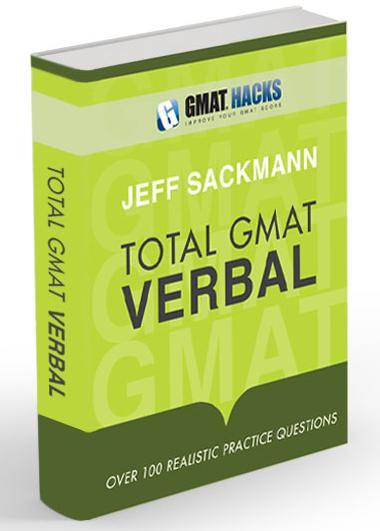
Bookshelf
|
|
Total GMAT Math Jeff's complete Quant guide, on sale now! |
|
|
Total GMAT Verbal Everything you need to ace GMAT Verbal! |
1,800 Practice Math Questions
Buy Jeff's books at Amazon.com

GMAT Official Guide, with IR
OG Math | OG Verbal
OG12 & Quant Rev solutions!
GMAT Question of the Day
Beginner's Guide to the GMAT
GMAT Hacks Affiliate Program

Recent Hacks

Categories
- General Study Tips
- Goals and Planning
- CAT Strategy
- The Mental Game
- GMAT Math Strategy
- GMAT Math Topics
- Mental Math
- Data Sufficiency
- Critical Reasoning
- Reading Comprehension
- Sentence Correction
- Analytical Writing Assessment
- Integrated Reasoning
- IR Explained
- Business School Admissions
- GMAT Prep Resources
- Practice Questions
- Total GMAT Math
- Total GMAT Verbal
- GMAT 111

GMAT Tricks and Shortcuts
| You should follow me on Twitter. While you're at it, take a moment to subscribe to GMAT Hacks via RSS or Email. |
Students frequently want me to give them a list of GMAT "tricks," as if I might have a secret code that allows them to ace the GMAT with nothing more than a few flashcards and the right attitude.
That's precisely the wrong way to look at test preparation. It doesn't matter whether you're scoring a 380 or a 680. Shortcuts are not the answer. At best, they are a small part of it.
The makers of the GMAT know full well what test prep companies are up to. GMAT questions are created in such a way to test your mathematical reasoning and avoid rewarding those who know a bunch of shortcuts.
Fundamentals Are Key
That's why I'm always preaching the fundamentals. Total GMAT Math and Total GMAT Verbal are built around the fundamentals. Your study plan--again, whether you're in the 10th percentile or the 90th percentile--should be as well.
Think of it this way. There are plenty of cool tricks out there, even on this site. (I don't emphasize them, but that doesn't mean I don't enjoy them!) Take this one, which explains how to find the number of factors of a large integer. If you know the relevant technique, you can save 60 seconds or so if the GMAT asks you to find the number of factors of 294. Pretty nifty, huh?
Here's the rub. What do you think the odds are that the GMAT will ask you for the number of factors of a large integer? I would guess that, at an absolute maximum, that question shows up on about one in ten GMATs. Probably not that many. How many shortcuts like that do you need to learn before you make a measurable dent in your target score?
Techniques, Not Tricks
Note, as well, that even in the trick I'm describing, I turn the focus to what makes it work. This is something that many test prep resources don't do. (It's a key reason why I frown on the "picking numbers" strategy used so heavily by Kaplan and The Princeton Review.) If the discussion helps you understand factorizations and permutations, fantastic.
That's a lot more valuable than learning a faster way to find the number of factors in a large integer.
I promise you: If you master the fundamentals and can execute them quickly enough to answer practice questions in less than two minutes, there is virtually no limit how high you can score on the GMAT. You can turn your 380 into a 550, or your 680 into a 750.
But no matter how many times I say that, most people don't.
Set Yourself Apart
Learning fundamentals isn't a matter of making some flashcards and reading through an algebra book.
It comes down to lots and lots of practice. Then a lot more. Practice recognizing question types, practice setting up equations, practice isolating variables, practice plotting graphs on the coordinate plane...the list goes on.
GMAT tricks are the icing on the cake--and to extend the metaphor, they have no nutritional value. They'll occasionally shed light on some broader technique, but that isn't where you should be spending your time. No matter how strong your fundamentals are, if you're reading this site, your fundamentals could be stronger.
(By the way, there are 12 factors of 294.)
About the author: Jeff Sackmann has written many GMAT preparation books, including the popular Total GMAT Math, Total GMAT Verbal, and GMAT 111. He has also created explanations for problems in The Official Guide, as well as 1,800 practice GMAT math questions.
 |
Total GMAT Verbal
The comprehensive guide to the GMAT Verbal section. Recognize, dissect, and master every question type
you'll face on the test. Everything you need, all in one place, including 100+ realistic practice questions. |